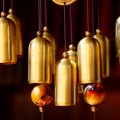Introduction: Superstition, Space, and Symbolism Across Cultures
Superstitions, far from being mere relics of a bygone era, continue to shape the way people navigate their environments and interpret daily occurrences. In both Chinese Feng Shui and British folklore, symbolic objects—such as magpies, horseshoes, and mirrors—hold powerful sway over beliefs about luck, fortune, and wellbeing. These traditions reveal how deeply embedded superstitions are in cultural consciousness, influencing not only individual behaviour but also the organisation of homes and public spaces. By examining the enduring presence of these symbols, we can uncover striking parallels in how different societies strive to manage uncertainty and invite prosperity. Whether through arranging furniture in alignment with Feng Shui principles or hanging a horseshoe above the door for good luck, both cultures demonstrate a shared human impulse to influence fate through ritual and symbolism. This exploration sets the stage for a comparative analysis of how superstition intersects with daily life, spatial arrangement, and collective mindset across East and West.
2. The Magpie and the Power of Omens
Among the most recognisable birds in British folklore, the magpie carries a reputation that is both fascinating and divisive. Rooted in centuries-old superstition, the magpie is often seen as an omen—its appearance interpreted as either good or ill fortune depending on context and number. The well-known rhyme “One for sorrow, two for joy…” encapsulates this belief, suggesting that the mere sighting of these birds can influence one’s luck. This motif of animal symbolism finds a striking parallel in Feng Shui, where animals are also believed to possess the power to attract auspicious or inauspicious energies.
The Magpie in British Folklore
In Britain, magpies are frequently associated with duality: they are admired for their intelligence but feared for their supposed connection with misfortune. The interpretation hinges on how many magpies one encounters, reflecting a nuanced system of omens unique to local culture. For example, a solitary magpie is traditionally linked to sorrow, while pairs signify happiness or harmony. Some individuals even greet lone magpies with respectful gestures or phrases to ward off bad luck—a practice echoing ritualistic behaviour found worldwide.
Animal Symbolism in Feng Shui
Feng Shui, rooted in Chinese cosmology, attributes symbolic power to certain animals within the domestic environment. Birds, particularly magpies (known as “xǐquè” or 喜鹊), are heralded as harbingers of good news and marital bliss. Unlike their British counterparts, Feng Shui magpies are almost exclusively positive omens, often depicted alongside blooming plum blossoms to represent joy and successful relationships.
Comparative Table: Magpie Symbolism
| British Folklore | Feng Shui Tradition | |
|---|---|---|
| General Association | Ambivalent (good or bad omen) | Positive (joy, good fortune) |
| Number Matters? | Yes (“One for sorrow… two for joy”) | No, generally always positive |
| Rituals/Remedies | Saluting/greeting single magpies to avert misfortune | No specific rituals; placement of imagery sufficient |
| Common Imagery | Lone or paired magpies; rhymes and superstitions | Magpies with plum blossom; festive decor motifs |
Cultural Implications and Shared Motifs
The comparison highlights both divergence and convergence in how animal symbolism functions within each tradition. While British folklore emphasises the unpredictability of fate as reflected through nuanced interpretations of magpie sightings, Feng Shui channels symbolic meaning towards harmonious outcomes by focusing on positivity and auspiciousness. Both cultures demonstrate a deep-seated human impulse to read signs from nature—using animal symbolism as a tool to make sense of uncertainty and influence personal fortune.

3. Horseshoes: Doors to Luck and Protection
In British folklore, the horseshoe is a potent emblem of fortune and safeguarding, most commonly found above doorways, whether that be on quaint country cottages or urban terraced homes. The custom of nailing a horseshoe above the entrance—traditionally with the open end facing upward to ‘catch’ luck—stems from centuries-old beliefs in warding off evil spirits and attracting prosperity. Notably, this tradition resonates deeply with the symbolic practices found in Feng Shui, where thresholds are viewed as vital channels through which energy (qi) flows into a dwelling.
Much like how the British employ horseshoes as protective charms at entry points, Feng Shui prescribes careful attention to entrances. In Chinese geomancy, doors are more than functional elements—they serve as portals for auspicious energy to enter and circulate. Practitioners recommend using objects such as Bagua mirrors or specific plant arrangements near the main entrance to dispel negative influences and foster positive qi, echoing the British instinct to use tangible symbols as shields against misfortune.
This parallel highlights a shared cultural intuition: both traditions recognise the threshold not merely as a boundary but as a zone of vulnerability and potential. While the British might select a weathered iron horseshoe for its rustic authenticity, Feng Shui adherents may opt for items aligned with the five elements or personalised to an individual’s birth details. Despite their differing origins, each system demonstrates a rational logic—if one can influence what crosses their threshold, one can shape their domestic fate.
4. Mirrors: Portals, Reflections, and the Movement of Energy
Mirrors occupy a curious place in both British folklore and Feng Shui, functioning as more than mere objects for physical reflection. Their presence is believed to actively influence the flow of energy, fortune, and even spiritual entities—either inviting luck or warding off misfortune, depending on how they are used or positioned. By deconstructing the duality embedded in these beliefs, we can uncover surprising parallels in cultural attitudes towards intent, energy, and the unseen forces that shape our lives.
The Dual Nature of Mirrors in British Folklore
In traditional British superstition, mirrors are often regarded with a sense of caution and reverence. Breaking a mirror is famously said to bring seven years of bad luck—a belief rooted in the idea that mirrors not only reflect our image but also capture part of our soul or essence. Covering mirrors during periods of mourning is another well-known custom, intended to prevent restless spirits from becoming trapped or causing harm to the living. At the same time, strategically placed mirrors are thought to deflect negative energies or malevolent spirits away from the home.
Mirrors as Conduits in Feng Shui
Feng Shui similarly attributes great significance to mirrors, viewing them as powerful tools for manipulating Qi (energy). Proper placement can attract prosperity, enhance natural light, and circulate positive energy within a space. Conversely, mirrors placed opposite doors or beds are believed to bounce energy away or disrupt harmony—potentially inviting ill fortune if used incorrectly. The intention behind their placement is crucial; it transforms the mirror from a neutral object into an active participant in shaping household destiny.
Comparative Table: Mirror Symbolism
| Aspect | British Folklore | Feng Shui |
|---|---|---|
| Primary Role | Soul reflection; spiritual portal | Energy flow enhancer or disruptor |
| Bad Luck Association | Breaking brings seven years’ misfortune | Poor placement disperses Qi/wealth |
| Protective Use | Covers during mourning; wards off spirits when facing outward | Reflects negative energy away from entrance; brightens dark spaces |
| Key Principle | Intent determines outcome (protection vs. danger) | Intent guides energy movement (prosperity vs. disharmony) |
The Underlying Belief: Intent Shapes Outcome
Beneath both traditions lies a fundamental conviction: mirrors act not simply as passive surfaces but as channels through which human intention interacts with unseen energies. Whether safeguarding one’s spirit or optimising the home’s energetic balance, the symbolism surrounding mirrors reflects a shared understanding that material objects can bridge worlds—physical and metaphysical alike—when wielded with purpose. This parallel demonstrates how deeply-rooted beliefs about luck, protection, and prosperity transcend cultural boundaries, mediated by familiar household items like mirrors.
5. Common Threads: The Psychological Function of Meaning-Making
Across the seemingly disparate worlds of British folklore and Chinese feng shui, a clear psychological undercurrent emerges: both cultures rely on symbolic practices as tools for managing uncertainty and anxiety. Whether it is the magpies call, the placement of a horseshoe above a doorway, or the strategic positioning of mirrors to redirect energy, these rituals offer a sense of control in the face of lifes unpredictability. Anthropologically, this phenomenon can be understood as a universal human response to the unknown; when confronted with forces beyond immediate comprehension—be it ill fortune or unexplained misfortune—communities develop systems imbued with meaning to help rationalise their experiences.
Rituals as Emotional Anchors
Symbolic objects and actions act as emotional anchors. For example, the British tradition of greeting a solitary magpie or hanging a horseshoe with its ends upwards are not just superstitions but mechanisms that provide individuals with reassurance. Similarly, in feng shui, mirror placement is not only about aesthetic balance but also about deflecting negative energy and inviting prosperity—serving much the same function as folk charms in British homes.
Cognitive Patterns and Pattern Recognition
Underlying these traditions is an innate human tendency towards pattern recognition—a cognitive shortcut that enables us to make connections between events and outcomes. When a specific arrangement appears to ward off bad luck or attract good fortune, it becomes codified through generations. This is evident in both cultures: British tales abound with cautionary stories involving broken mirrors or misplaced horseshoes, while feng shui literature details auspicious and inauspicious object placements based on centuries-old observations.
The Comfort of Shared Belief
Importantly, these rituals are seldom practiced in isolation; they are shared social constructs that reinforce communal bonds. The collective act of subscribing to such beliefs—be it wishing someone good luck after spotting two magpies or consulting a feng shui expert before moving house—fosters solidarity and mutual understanding. By engaging in these practices, individuals participate in a broader cultural narrative that validates their anxieties and provides structured ways to address them.
Ultimately, the parallels between British folklore and feng shui symbolism reveal more than mere coincidence; they underscore humanitys enduring quest for meaning amidst chaos. These symbolic practices persist because they fulfil deep-seated psychological needs, enabling people from different backgrounds to navigate uncertainty with confidence and cohesion.
6. Conclusion: Bridging Traditions and Rethinking Modern Space
Reflecting on the shared threads between Feng Shui symbolism and British folklore, it becomes evident that human societies—regardless of geography—have long imbued everyday objects with profound meaning. From magpies and horseshoes in rural England to mirrors and bagua in traditional Chinese homes, these items serve as touchstones for luck, protection, and harmony. Recognising the universality of such symbolic practices invites us to approach our own living spaces with renewed curiosity and respect for diverse traditions.
In modern Britain, where multiculturalism shapes daily life, acknowledging these parallels offers an opportunity to move beyond mere superstition or decorative whimsy. Instead, it encourages a more thoughtful, culturally nuanced engagement with the environments we create. Integrating meaningful objects into our homes need not be a nostalgic nod to the past; rather, it can foster a sense of belonging, wellbeing, and connection across generations and backgrounds.
Ultimately, bridging the wisdom of Feng Shui with the rich tapestry of British folklore allows us to rethink what it means to design spaces that nurture both body and mind. By valuing the intentions behind symbolic objects—whether inherited from family tradition or inspired by global practices—we cultivate homes that are not only aesthetically pleasing but also deeply supportive of our personal and collective wellbeing.


